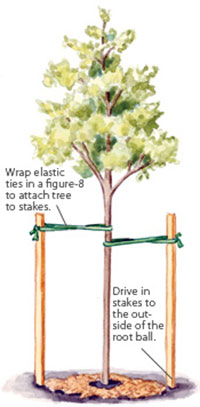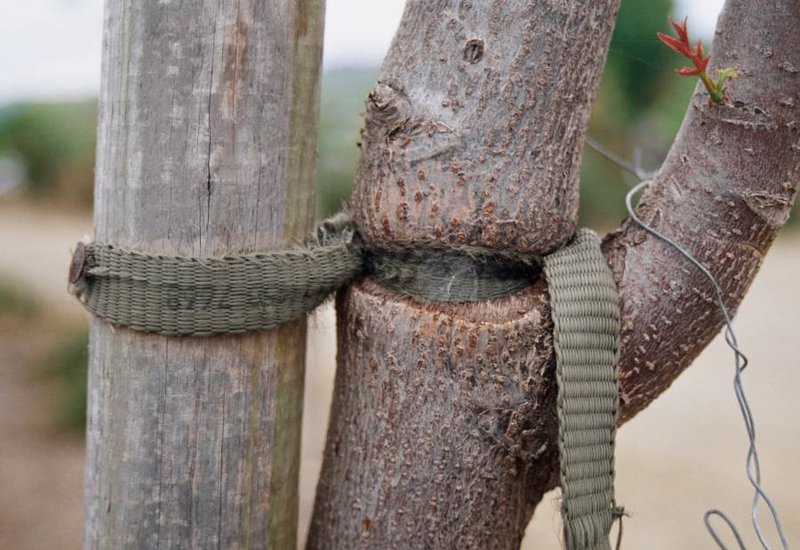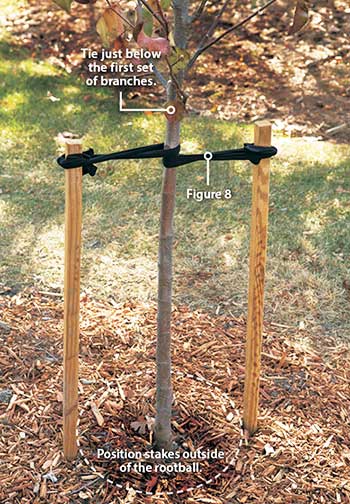How to Stake a Tree
The proper way to do it
Why Stake?

Not all trees need stakes and determining when and when not to stake generally arises from the amount of exposure to wind on the site where you're planting the tree, and the plant's height to root ball ratio. Usually, only trees greater than 1/2-inch (1.5cm) caliper require staking. 1/2-inch caliper corresponds to a tree approximately 4-5 feet (120-150cm) tall.
When the root ball is small in comparison to the height of the tree or density of its crown, then staking is a good idea to help secure the tree into the ground while it establishes it's root paths. Wind coursing through a dense crown of leaves on a tree with a small root ball can cause a 'crow bar' hole as the tree moves back and forth. A crow-bar hole forms a gap around the roots where water logs and eventually can cause root-rot.
When the tree is short with a larger root ball, and if planted in an appropriate depth hole, it shouldn't need staking. Be mindful, however, of the degree of wind exposure the plant might encounter on the site chosen for planting.
Stakes:
Ground treated 1.2m stakes (50mm square);
- 2 stakes for most domestic gardens; or
- 3 stakes for larger exposed sites.
Tree ties:
When tying the tree ties, ensure that they are neither too tight nor too loose, and are tied in an appropriate place on the trunk (i.e. not too high) - at the base of the first/lowest branches is usually correct.
Tight ties result in girdling of the trunk under the tie which strips the bark causing weakening and possibly death of the tree. Movement of a tree is nature's way of enabling the trunk to grow thick and strong but if tied too tightly to a stake only the part of the tree above the tie will have any movement. This imbalance will impact the smooth travelling of water and nutrients to the roots as the thickness of the trunk above the tie becomes larger than below the tie.

Too loose ties can result in rubbing of the tie against the bark causing damage and wounds that may never heal properly and leaves the tree exposed to bacteria and disease.
Directions:
- Bang the stakes into the ground, to a depth of around 600mm [2 feet]:
- Ensure the stakes are positioned outside of the root ball and in undisturbed soil if possible (gives extra strength)
- Ensure the stakes are facing into the prevailing wind
- Ensure the stakes are straight or pointing slightly outward - if the stakes are pointing slightly outward they will pull in when you tie the tree giving you a nice vertical finish (this is more for appearance than effectiveness).
- Once your stakes are in the ground, using the tree-ties, tie the tree to the stakes:
- Tie/secure one end of the tree tie to the first stake at the height of where the first branches sit on the trunk
- Run your tie out to the tree and back again to measure the length required, allowing some extra length for tying the two ends, then cut where required
- Now run the length of tie back to the trunk and run it around the back side of the trunk. Then, on your way back to the stake, twist the tree tie over around the first length, like forming a figure 8
- Once back at the stake tie/secure it to the stake;
- Repeat for the other stakes.

Important Things to Remember
- Only leave stakes on the tree for the first 1-2 years
- Choose stakes appropriate width for your tree caliper - too large/thick will prevent any movement
- Never use wire or anything else which can cut into the bark
- Do not tie the ties too tight (hinders movement) or too loose (rubs bark reducing protection)
- Never use just one stake
15169